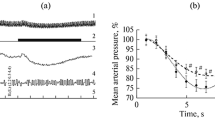Abstract
Chronic experiments were carried out on 19 adult cats after preliminary division of the brain stem at the level of the anterior border of the superior colliculus. High-frequency electrical stimulation of the posterior hypothalamus of these animals caused desynchronization of electrical activity in different parts of the neocortex. The influence of the posterior hypothalamus was predominantly on activity in the frontal zones of the neocortex. It is postulated on the basis of these results that the posterior hypothalamus has an activating effect on the neocortex through the thalamic nuclei.
Similar content being viewed by others
Literature cited
O. G. Baklavadzhyan, Autonomic Control of Brain Electrical Activity [in Russian], Nauka, Leningrad (1967).
E. Gellhorn and G. N. Loofbourrow, Emotions and Emotional Disorders, Harper (1963).
I. M. Gil'man, “Comparative analysis of ascending influences of the reticular formation and of some specific formations of the cat brain stem on the level of cortical activity,” in: Physiology and Pathology of the Limbico-reticular System [in Russian], Nauka, Moscow (1971), pp. 50–55.
E. A. Gromova, “Electrophysiological analysis of the specificity of ascending hypothalamic influences on the cortex,” in: Physiology and Pathophysiology of the Limbicoreticular System [in Russian], Nauka, Moscow (1971), pp. 47–50.
E. A. Gromova, K. N. Tkachenko, and V. N. Provodina, “Characteristics of functional connections of different regions of the rabbit hypothalamus,” Fiziol. Zh. SSSR,51, 768 (1965).
O. Sager, The Diencephalon [in Russian], Rumanian Academy of Sciences Press, Bucharest (1962).
A. I. Karamyan and T. N. Sollertinskaya, “On some features of development of hypothalamo-hemispheric relations in vertebrate phylogeny,” Fiziol. Zh. SSSR,50, 962 (1964).
L. V. Loskutova, “Changes in cortical bioelectrical activity during stimulation of various diencephalic structures,” Proceedings of the Third Scientific Conference of Physiologists, Pharmacologists, and Biochemists of the Western Siberian Union [in Russian], Tomsk (1965), p. 311.
W. D. Nauta and H. G. J. M. Kuypers, “Some ascending pathways in the brain stem reticular formation,” in: Reticular Formation of the Brain, Little, Brown and Co., Boston (1958), pp. 3–30.
J. Szentagothai, B. Flerko, B. Mess, and B. Halasz, Hypothalamic Regulation of the Anterior Pituitary [in Russian], Hungarian Academy of Sciences Press, Budapest (1965).
A. V. Tonkikh, The Hypothalamo-Hypophyseal Region and Regulation of the Physiological Functions of the Organism [in Russian], Nauka, Leningrad (1965).
H. L. Batsel, “Electroencephalographic synchronization and desynchronization in the chronic cerveau isole of the dog,” Electroenceph. Clin. Neurophysiol.,1, 421 (1960).
H. Berger, “Uber das Elektrenkephalogram des Menschen,” Arch. Psychiat.,87, 527 (1929).
E. W. Dempsey and R. S. Morison, “The production of rhythmically recurrent cortical potentials after localized thalamic stimulation,” Amer. J. Physiol.,135, 293 (1942).
C. von Economo, “Sleep as a problem of localization,” J. Nerv. Ment. Dis.,71, 219 (1930).
E. Gellhorn, Autonomic Imbalance and the Hypothalamus, Minneapolis (1957).
J. D. Green and F. Morin, “Hypothalamic electrical activity and hypothalamo-cortical relationships,” Amer. J. Physiol.,172, 175 (1953).
J. A. Hobson, “The effect of chronic brain-stem lesions on cortical and muscular activity during sleep and waking in the cat,” Electroenceph. Clin. Neurophysiol.,19, 41 (1965).
W. Ingram, J. Knott, M. Wheatley, and T. Summers, “Physiological relationships between hypothalamus and cerebral cortex,” Electroenceph. Clin. Neurophysiol.,3, 37 (1951).
H. H. Jasper and C. Ajmone-Marsan, A Stereotaxic Atlas of the Diencephalon of the Cat, National Research Council of Canada, Ottawa (1954).
D. B. Lindsley, L. H. Schreiner, W. P. Knowles, and H. W. Magoun, “Behavioral and EEG changes following chronic brain stem lesions in the cat,” Electroenceph. Clin. Neurophysiol.,2, 483 (1950).
D. B. Lindsley, “Attention, consciousness, sleep, and wakefulness,” in: Handbook of Physiology, Section: Neurophysiology, Vol. 3, American Physiological Society, Washington (1960), pp. 1553–1593.
C. Moruzzi and H. W. Magoun, “Brain stem reticular formation and activation of the EEG,” Electroenceph. Clin. Neurophysiol.,1, 455 (1949).
C. Moruzzi, M. Palestrini, G. F. Rossi, and A. Zanchetti, “Comportamento e quadro electroencefalografico nelgatto dopo lesioni complete o parziali della sostanza reticulare mesencefalica,” Boll. Soc. Ital. Biol. Sper.,32, 958 (1956).
J. P. Murphy and E. Gellhorn, “The influence of hypothalamic stimulation on cortically induced movements and on action potentials of the cortex.” J. Neurophysiol.,8, 341 (1945).
W. J. Nauta, “Hypothalamic regulation of sleep in rats. An experimental study,” J. Neurophysiol.,9, 285 (1945).
W. J. Nauta and P. A. Gygax, “Silver impregnation of degenerating axons in the central nervous system,” Stain Technol.,29, 91 (1954).
S. W. Ranson, “Somnolence caused by hypothalamic lesions in the monkey,” Arch. Neurol. Psychiat.,41, 1 (1939).
T. Tokizane, “Sleep mechanism, hypothalamic control of the cortical activity,” in: Aspects Anatamofonctionnels de la Physiologie du Sommeil, Paris (1965), pp. 151–184.
J. Villabianca, “The electrocorticogram in the chronic cerveau isole cat,” Electroenceph. Clin. Neurophysiol.,19, 576 (1965).
Author information
Authors and Affiliations
Additional information
Translated from Neirofiziologiya, Vol. 8, No. 1, pp. 47–53, January–February, 1976.
Rights and permissions
About this article
Cite this article
Naneishvili, T.L., Bakuradze, A.N., Noselidze, A.G. et al. Effect of posterior hypothalamic stimulation on neocortical electrical activity in the chronic premesencephalic cat. Neurosci Behav Physiol 7, 292–298 (1976). https://doi.org/10.1007/BF01181835
Received:
Issue Date:
DOI: https://doi.org/10.1007/BF01181835



